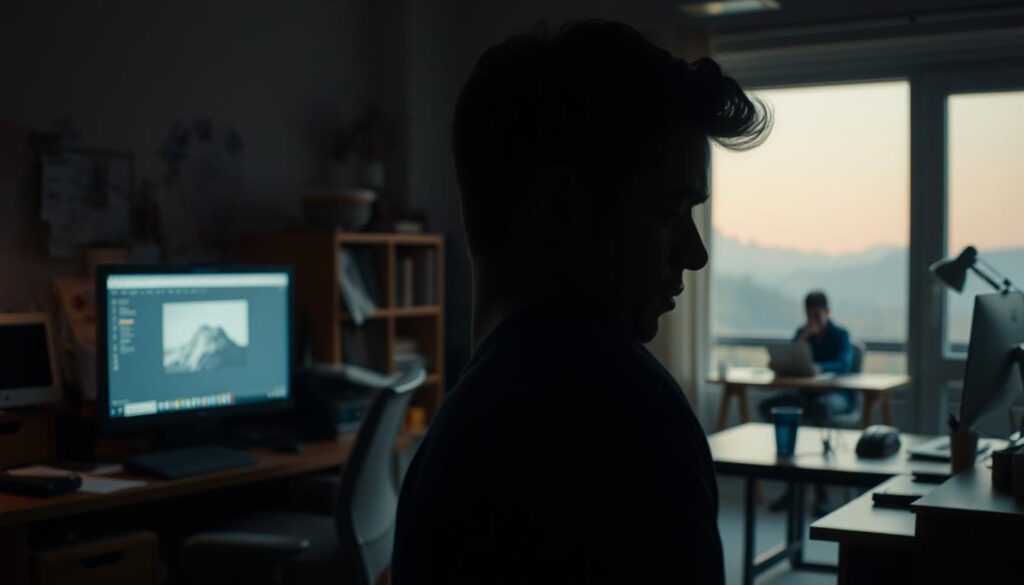Imagine completing critical tasks in half the time while producing higher-quality results. This isn’t a fantasy—it’s the reality for those who master focused, distraction-free sessions. Cal Newport’s research reveals that elite performers achieve breakthroughs by protecting their cognitive resources through intentional isolation.
Take Bill Gates’ legendary “think weeks”—twice-yearly retreats where he disconnects from daily demands to strategize. These sessions led to pivotal innovations like Internet Explorer. Similarly, studies show knowledge workers waste 60% of their day on shallow tasks like emails, leaving little room for high-impact work.
The solution? Structured blocks of uninterrupted concentration. By silencing notifications and dedicating mornings to complex projects, professionals reclaim their mental bandwidth. Gloria Mark’s research confirms interruptions cost 23 minutes of recovery time—a tax few can afford.
This approach isn’t about grinding longer hours. It’s designing routines that align with your brain’s natural rhythms. Whether writing code or crafting strategies, prioritizing depth over reactivity unlocks unprecedented efficiency. Ready to transform how you approach your day?
Key Takeaways
- Distraction-free sessions enable breakthroughs by maximizing cognitive potential
- Elite performers like Bill Gates use isolation to fuel innovation
- Shallow tasks consume 60% of typical workdays without strategic planning
- Interruptions require 23 minutes of recovery time on average
- Morning hours often yield peak concentration for complex projects
- Structured routines prevent mental fatigue while boosting output quality
Understanding the Concept of Deep Work
In an age of constant connectivity, the ability to concentrate without interruption has become a rare superpower. Cal Newport, a computer science professor and productivity expert, coined the term “deep work” to describe this focused state. He defines it as “professional activities performed in distraction-free concentration that push cognitive capabilities to their limit”.

Defining Deep Work and Its Origins
Newport introduced this concept in his 2016 bestseller, arguing that sustained attention drives exceptional results. Unlike reactive tasks like answering emails, deep work requires deliberate practice.
“To produce at your peak level, you need to work for extended periods with full concentration,”
he writes. This approach aligns with what Newport calls themonastic philosophy—creating sacred spaces for thinking.
Differences Between Deep and Shallow Work
Consider these contrasts:
| Deep Work | Shallow Work |
|---|---|
| Designing software features | Attending status meetings |
| Writing research papers | Responding to team chats |
| Strategic planning sessions | Sorting through notifications |
Research by Sophie Leroy reveals why this matters. When switching between tasks, attention residue leaves people mentally stuck on previous activities. This explains why checking your phone during a project might derail progress for 20+ minutes. By protecting mornings or specific days for intense focus, professionals create disproportionate impact compared to scattered efforts.
Benefits and Impact of Deep Work
The human brain achieves remarkable feats when shielded from modern noise. Neuroscience confirms that regular focused sessions rewire neural pathways, accelerating skill mastery and problem-solving abilities. This transformation occurs through myelin production—a process that strengthens connections between brain cells during intense concentration.

Cognitive Advantages of Focused Effort
Studies reveal workers in distraction-free environments produce 50% higher-quality output compared to those juggling multiple tasks. A University of California Irvine study found interruptions drain 23 minutes of recovery time per disruption—equivalent to losing 16 workdays annually for average professionals.
| Focused Work Outcomes | Scattered Work Outcomes |
|---|---|
| 72% faster complex skill acquisition | 40% more errors in routine tasks |
| 3x creative idea generation | Frequent context-switching fatigue |
| Enhanced long-term memory retention | Surface-level understanding |
Regular immersion in challenging projects builds what psychologists call cognitive endurance. Just as athletes train muscles, professionals strengthen mental capacity through unlocking cognitive potential during sustained attention periods. Over six weeks, daily 90-minute sessions can reshape how the brain processes information.
This mental remodeling leads to career-defining results. Software developers who protect morning hours for coding produce cleaner architectures. Writers crafting novels in isolation often achieve richer character development. By prioritizing depth, individuals create work that stands apart in an era of constant reactivity.
Strategies to Practice Deep Work – Minimize Distractions
Crafting an environment that fuels concentration begins with intentional design. Research from Harvard Business Review shows professionals in purpose-built spaces achieve 67% higher output quality compared to those in cluttered areas. Start by designating a specific zone free from visual noise—a blank wall or noise-canceling headphones often work better than elaborate setups.

Establishing a Focused Environment and Clear Rituals
Morning rituals act as cognitive triggers. Cal Newport suggests brewing tea or arranging tools before starting—actions signaling “this space means business”. Tech leaders like Kristin Pater use five-minute meditation to transition into flow states. These habits build neural pathways that automate focus over time.
Techniques Inspired by Productivity Pioneers
Corporate Rebels’ “Focus Fridays” demonstrate the power of collective commitment. Teams block four-hour windows using shared calendars, silencing all non-urgent communication. For solo practitioners, Newport’s time-block method proves effective:
| Strategy | Outcome |
|---|---|
| 90-minute sessions | Peak cognitive performance |
| Phone in airplane mode | 73% fewer interruptions |
| Visual progress boards | 42% faster task completion |
Scheduling and Prioritization Methods for Optimal Focus
1. Map energy peaks using time-tracking apps
2. Block three 90-minute slots weekly
3. Enable device focus modes during sessions
4. Schedule shallow tasks post-lunch
5. End with a ritual (e.g., journaling wins)
This structured approach transforms scattered efforts into value-creating momentum. As Newport emphasizes in his book, “What we practice grows stronger”—including the skill of sustained attention.
Building Your Deep Work Routine
Constructing a sustainable routine requires aligning your schedule with cognitive strengths. Start by identifying energy peaks—most people achieve peak concentration during morning hours. Reserve these golden periods for high-value cognitive capabilities limit activities like coding or strategic planning.
Creating Daily and Weekly Planning Habits
Tech leader Kristin Pater schedules “focus buckets” each week—dedicated blocks for infrastructure projects and creative tasks. Try this approach:
| Daily Strategy | Weekly Strategy |
|---|---|
| 90-minute morning sessions | Wednesday “shallow task” days |
| Post-lunch email batches | Friday progress reviews |
| 5pm shutdown ritual | Monthly goal mapping |
Tools like Asana help break large objectives into structured approach sessions. Cal Newport suggests planning four weeks ahead to maintain momentum.
Tracking Progress and Adjusting Your Routine
Measure what matters. Apps like Timely track time spent on different tasks, while simple spreadsheets can log output quality. Aim for 3-4 hours of focused time deep work daily initially.
Review metrics weekly. Did afternoon meetings drain energy? Move creative work earlier. Struggling with consistency? Try 60-minute sessions instead. Like DevOps teams iterating workflows, tweak your schedule until it clicks.
Remember: The best routine evolves. As Newport notes in his book, “Skill in focused labor grows through deliberate refinement.” Your ability to produce exceptional results depends on continuous calibration.
Overcoming Digital Distractions
Digital noise bombards professionals with 200+ daily interruptions—a modern challenge requiring tactical solutions. Leaders like Kristin Pater cut through this chaos using strategic digital boundaries that protect cognitive resources. The key lies in transforming devices from attention thieves into productivity allies.
Implementing Notification Controls and Focus Modes
Corporate Rebels’ teams reduced app-switching costs 84% by activating system-wide “Focus Fridays”. Their approach:
- Enable Do Not Disturb mode during morning creative sprints
- Batch-check emails in 20-minute afternoon windows
- Use app blockers to restrict social media access
Research reveals workers regain 23 minutes per interruption when silencing phones—equivalent to recovering 31 workdays annually. Tools like Freedom.app help maintain state distraction-free concentration by blocking distracting websites during critical sessions.
| Digital Strategy | Impact |
|---|---|
| Scheduled focus modes | 63% fewer task switches |
| Notification blackouts | 41% faster problem-solving |
| Single-app immersion | 2x output quality |
Adopt the monastic philosophy for digital spaces: design device settings that mirror a library’s quiet intensity. As one tech CEO reported, “Phone lockdowns during strategic hours helped our team ship products 3 weeks ahead of schedule.” Start with 90-minute notification-free blocks—your capabilities limit might surprise you.
Conclusion
Mastering focused effort reshapes how professionals achieve meaningful outcomes. As Cal Newport’s book demonstrates, deep work transforms scattered hours into strategic progress—whether through Bill Gates’ retreats or Kristin Pater’s structured routines. This approach isn’t about raw effort, but aligning energy with cognitively demanding tasks that push capabilities.
Leaders who prioritize quality over quantity produce results others struggle to match. Corporate Rebels’ teams prove that silencing phones and scheduling work sessions can multiply output. The key lies in consistency: small daily blocks of undivided attention compound into breakthroughs.
Your journey starts with one session. Design a routine that shields your best hours from distraction. Over time, these focused efforts create new value that’s hard to replicate in our hyper-connected world. The reward? Work that matters—and the quiet confidence of knowing you’ve mastered your craft.
FAQ
How does Cal Newport’s approach differ from traditional productivity methods?
Newport emphasizes cognitive intensity over multitasking. His philosophy prioritizes uninterrupted blocks for high-value tasks—contrasting with reactive workflows that prioritize responsiveness over meaningful output. This method aligns with research on neuroplasticity and skill mastery.
Can team environments support distraction-free concentration?
Yes—through scheduled collaboration windows and shared focus protocols. Teams using tools like Slack’s Do Not Disturb mode or Microsoft Focus Sessions report 31% fewer context switches. The key is aligning deep work sessions with organizational rhythms.
What’s the optimal duration for morning deep work sessions?
Studies show 90-120 minute blocks maximize cognitive capabilities before mental fatigue sets in. Start with 25-minute intervals using timers like Pomodone, gradually extending sessions as focus muscles strengthen. Morning hours leverage peak circadian alertness for complex tasks.
How do focus modes in apps like Forest or Freedom reduce shallow work?
These tools create behavioral friction against distractions. Forest grows virtual trees during uninterrupted work, while Freedom blocks addictive sites. Users average 28% more time on cognitively demanding tasks within six weeks of consistent use.
Why do some professionals adopt monastic philosophy for creative projects?
Radical elimination of distractions—like author Neal Stephenson’s offline writing periods—helps push cognitive limits. While impractical for most, temporary monastic phases during critical projects can yield breakthrough results unavailable through fragmented work.
Can tracking tools like Toggl or RescueTime improve deep work consistency?
Absolutely. Quantifying focus hours reveals patterns—maybe your best concentration happens post-lunch rather than mornings. Over eight weeks, users who review metrics weekly increase valuable output by 19% through smarter schedule adjustments.




























































